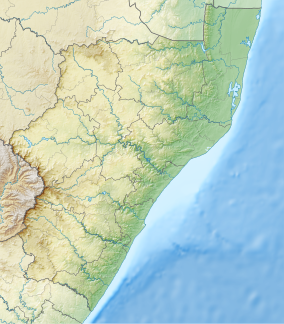Krantzkloof Nature Reserve
| Krantzkloof Nature Reserve | |
|---|---|

The upper Molweni gorge
|
|
|
Location on a map of KwaZulu-Natal
|
|
| Location | KwaZulu-Natal, South Africa |
| Nearest city | Pinetown |
| Coordinates | 29°45′51″S 30°51′03″E / 29.764303°S 30.850883°ECoordinates: 29°45′51″S 30°51′03″E / 29.764303°S 30.850883°E |
| Established | 1950 by Natal Parks Board |
The Krantzkloof Nature Reserve, managed by Ezemvelo KZN Wildlife, conserves 584 ha of the Molweni (Zulu: 'mutual greetings') and Nkutu River gorges that incise the sandstone Kloof plateau in KwaZulu-Natal, South Africa. The reserve conserves coastal scarp forest, sourveld grassland, a cliff face biotope, and aquatic environments along its rivers. Scarp forest is a threatened forest type, protected by South Africa's forests act of 1998, while the grassland is classified as KwaZulu-Natal sandstone sourveld, the most threatened terrestrial habitat in the Durban metropole. The reserve was established in 1950 and was augmented by land donations as late as 1999.
The reserve is situated at 140 to 520 m.a.s.l, and borders on suburbs, informal settlements, and in some of the catchment areas, on privately owned conservancies. The Kloof conservancy manages the Ronald's Kloof stream project, which effectively adds 5 ha to the reserve. The Springside and Iphithi Nature Reserves, in addition to the Everton conservancy, conserve natural remnants of the Molweni and Iphithi rivers' upper catchment.
The forested Molweni gorge divides the residential suburbs of Kloof and Forest Hills, and is intersected by Kloof Falls Road. This road provides access to the main Kloof Falls picnic site, from where walking trails diverge in both the upstream and downstream directions. The Molweni and Nkutu rivers converge to join 1 km outside the reserve, and some 2 km from the Umgeni. The reserve and conservancies are included in Durban's open space system, D’MOSS.
The reserve is situated on Natal group sandstone of the Cambrian to Ordovician periods, some 490 million years old, and artifacts recovered from its rock shelters indicate that it was once inhabited by early iron age people.
...
Wikipedia

